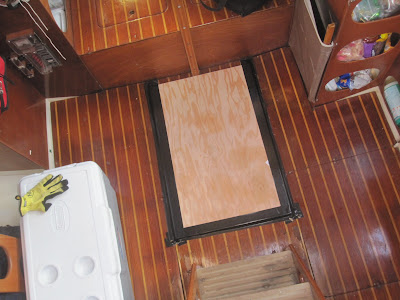 |
| It's not easy to leave a setting like this to go work on a boat. Yesterday's visit to the boat allowed us a glimpse of the long list of things that needed to get done before we could depart. |
Unfortunately, much of Bill's time was focused on trying to get the system working and that added to the overall stress level. Also, his lack of organizational skills became fairly evident when it was time to work on the boat. I figured out pretty quick to make a list and decide how and when to do the work. There were times we could only do so much on the boat and then had to leave to get tools, supplies, parts and lunch. Parts were scattered on the boat and in Gib's garage and outside shed. Since Gib and Jackie were at work it was left to us to find the pieces. I was very disappointed to have shown up and the boat not being ready. A delivery crew should show up and get provisions and not have to put a boat back together. There are months and weeks and days ahead of planned departures that should be utilized.
Bill spent a lot of time on the phone with the software company representing the communication software that was loaded in the laptop needed to allow e/m's to be sent and received from the laptop through the satellite phone. Up until the night before departure we had no way to communicate with land while offshore due to various connection problems. Bill could not get it to work. Apparently, Clive had words with Bill expressing his anger at the lack of communication and let him know that it was not acceptable to go offshore with no way to communicate. This came out of a growing frustration directed at Bill for being unprepared and having a lack of managerial skill. All crews must have someone that is ultimately in charge and we looked to Bill to be the Captain. If he could not be the Captain on shore then it was most likely he would not be a leader off shore.
 | ||||||||||||||||||||||||||||||||||||||||||||||||||||||||||||||||||||||||||||||||||||||||||||||||||||||||
| Chasch Mer is located at the end of the dock on the far left in the above picture. |
 |
| Chasch Mer dead-center at the end of the dock. |
 |
| The height of Chasch Mer's mast gives some perspective on her surroundings. |
There were so many projects on the list we needed to divide the crew into two groups so we could maximize our time. Luckily we had two vehicles.
The floorboard at the base of the companionway steps had de-laminated in places and was structurally unsound in a couple places. This is the landing at the base of the companionway steps and everyone walks through this area making it incredibly unsafe to have this defect offshore. We got a piece of plywood from a hardware store that spanned the area and I duct-taped it in place. Instant strong floor to hold the large ice cooler with food.
 | ||
| Freshwater holding tanks amidships. |
 | ||
| The forward starboard water-tank cap is missing. |
The brand new Vetus diesel was installed prior to the 2007 Transpac and was in good working order. Other than having to put in oil on a regular basis if the engine was run for long periods this item remarkably performed well with no problems.
 |
| Clive and me adding water. |
 |
| Bill bending on the mainsail for an eminent departure. |


No comments:
Post a Comment